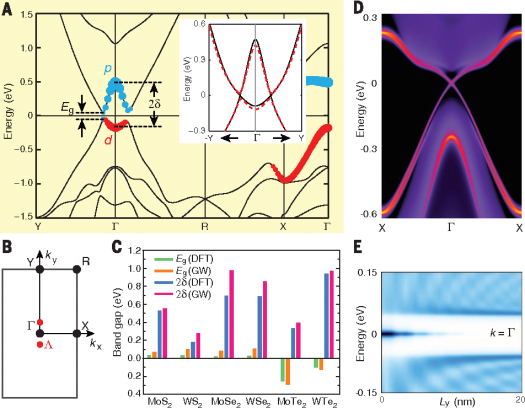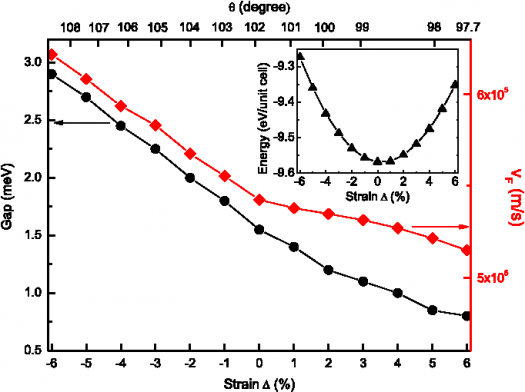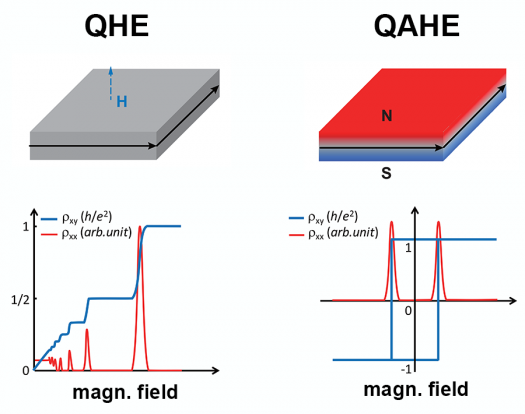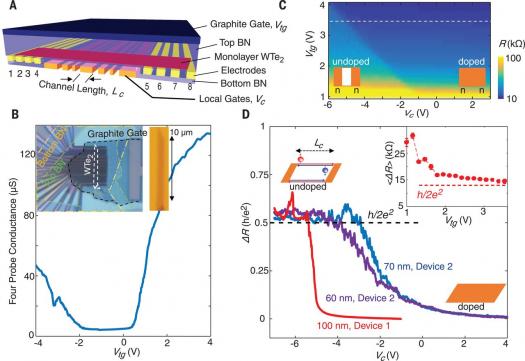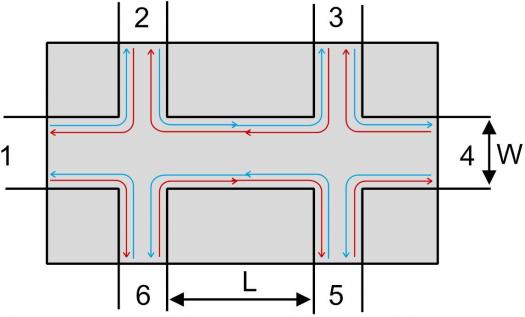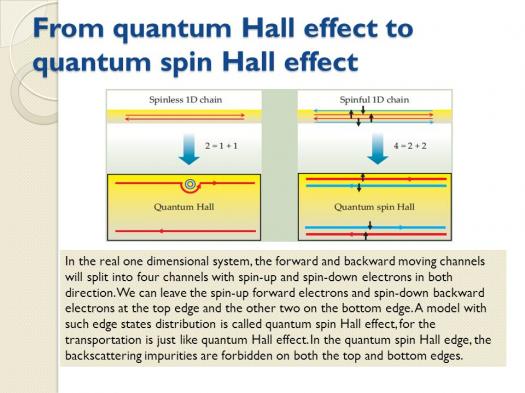What Do You Know About The Quantum Spin Hall Effect?
-
According to the two copies of the Haldane model, the spin-up electron exhibits which of the following?
-
A chiral integer quantum Hall effect
-
An anti-chiral integer quantum Hall effect
-
An anti-chiral fraction quantum Hall effect
-
An anti-chiral fraction quantum Hall effect
-
A lot--if not most--of quantum states of condensed matter are classified by the symmetries they break. The quantum spin Hall state is a state of the matter proposed to exist in special, and two-dimensional semiconductors. The purpose of this quiz is to give you room to test yourself regarding your knowledge in quantum spin Hall effect.
(159).jpg)
Quiz Preview
- 2.
Which of the following is false?
-
The quantum spin-Hall state of matter is the cousin of the integer quantum Hall state
-
The quantum spin Hall state of matter doesn't require application of a large magnetic field
-
The quantum spin Hall state breaks charge conservation symmetry
-
None of the above
Correct Answer
A. The quantum spin Hall state breaks charge conservation symmetryExplanation
The quantum spin Hall state of matter does not break charge conservation symmetry. Charge conservation symmetry refers to the principle that the total electric charge in a closed system remains constant over time. The quantum spin Hall state, on the other hand, is a state of matter that exhibits topological insulating behavior in two dimensions, where the edge states are protected by time-reversal symmetry. It does not involve any violation of charge conservation symmetry.Rate this question:
-
- 3.
A quantum spin Hall model was proposed by which of the given options?
-
Bernevig
-
Maciejko
-
Newton
-
Hughes
Correct Answer
A. BernevigExplanation
The correct answer is Bernevig. Bernevig, along with his colleagues, proposed the quantum spin Hall model. This model describes a new state of matter known as a topological insulator, where the bulk of the material is an insulator, but its edges or surfaces conduct electricity. The model has been influential in the field of condensed matter physics and has led to further research and discoveries in topological materials.Rate this question:
-
- 4.
The first proposal for the existence of a quantum spin Hall state was developed by who?
-
Charles Kane
-
F. Duncan M. Haldane
-
Gene Mele
-
A and B
-
A and C
-
B and C
Correct Answer
A. A and CExplanation
The correct answer is A and C. Charles Kane and Gene Mele both independently proposed the existence of a quantum spin Hall state. Their work, published in 2005, introduced the concept of a topological insulator, a material that behaves as an insulator in its interior but conducts electricity on its surface due to the presence of protected conducting states. This groundbreaking research laid the foundation for further studies and experiments in the field of topological insulators and quantum spin Hall effect.Rate this question:
-
- 5.
After the introduction of spin-up spin-down scattering, which of the following was realized?
-
That the quantum spin Hall state changes
-
That the quantum spin Hall state became trivial
-
That the quantum spin Hall state remained non-trivial
-
None of the above
Correct Answer
A. That the quantum spin Hall state remained non-trivialExplanation
After the introduction of spin-up spin-down scattering, it was realized that the quantum spin Hall state remained non-trivial. This means that the scattering did not cause a change in the nature of the quantum spin Hall state, indicating that it still retained its unique properties.Rate this question:
-
- 6.
Which of the following was proved by stability studies of the edge liquid through which conduction occurs in the quantum spin Hall state?
-
Non-trivial state is robust to interactions
-
Non-trivial state is robust to extra spin-orbit coupling terms that mix spin-up and spin-down electrons
-
A & B
-
Non-trivial state is protected by change conservation symmetry and time reversal symmetry
Correct Answer
A. A & BExplanation
The correct answer, A & B, suggests that stability studies of the edge liquid in the quantum spin Hall state have proven two things. First, the non-trivial state is robust to interactions, meaning that it remains stable even in the presence of external forces or interactions with other particles. Second, the non-trivial state is also robust to extra spin-orbit coupling terms that mix spin-up and spin-down electrons, indicating that it can withstand perturbations that could potentially disrupt its properties.Rate this question:
-
- 7.
The quantum spin Hall state has which of the following?
-
Semiconductors
-
Vanishing charge-Hall conductance
-
Quantized spin-Hall conductance
-
All of the above
Correct Answer
A. All of the aboveExplanation
The quantum spin Hall state exhibits all of the mentioned characteristics. It is a state of matter that occurs in certain semiconductors, where the charge-Hall conductance vanishes and the spin-Hall conductance is quantized. This means that the flow of charge and spin currents in the material is highly controlled and predictable, making it a promising candidate for applications in spintronics and quantum computing.Rate this question:
-
- 8.
A relativistic version of the quantum spin Hall effect was introduced when?
-
1980s
-
1990s
-
2000s
-
1970s
Correct Answer
A. 1990sExplanation
In the 1990s, a relativistic version of the quantum spin Hall effect was introduced. This suggests that the correct answer is the 1990s.Rate this question:
-
- 9.
Time reversal symmetry is not needed to protect quantum spin Hall state. Is the above statement true or false?
-
Yes, it's true
-
No, it's false
-
True but sometimes false
-
Depends on the Hall state
Correct Answer
A. Yes, it's trueExplanation
This statement is true. Time reversal symmetry is not necessary to protect the quantum spin Hall state. The quantum spin Hall state is a topological insulator that exhibits a non-trivial band structure and protected edge states. These edge states are protected by the presence of a bulk energy gap and the conservation of certain symmetries, such as particle-hole symmetry and time reversal symmetry. However, recent research has shown that certain systems can still exhibit a quantum spin Hall state even in the absence of time reversal symmetry, as long as other symmetries are present to protect the edge states.Rate this question:
-
- 10.
Which of the following is true?
-
Topological insulator and quantum spin Hall state are different states of matter
-
Symmetry - protected topological order is an example of topological insulator
-
Zhang and Haldane proposed the first quantum spin Hall model
-
All of the above
Correct Answer
A. Topological insulator and quantum spin Hall state are different states of matterExplanation
Topological insulator and quantum spin Hall state are different states of matter. This is because topological insulators are materials that are insulating in the bulk but conductive on the surface, while quantum spin Hall states are a specific type of topological insulator that exhibit a quantized spin Hall effect. Symmetry-protected topological order is another concept related to topological insulators, but it is not the same as a quantum spin Hall state. Zhang and Haldane did propose the first quantum spin Hall model, but this does not imply that topological insulators and quantum spin Hall states are the same.Rate this question:
-
Quiz Review Timeline (Updated): Mar 21, 2023 +
Our quizzes are rigorously reviewed, monitored and continuously updated by our expert board to maintain accuracy, relevance, and timeliness.
-
Current Version
-
Mar 21, 2023Quiz Edited by
ProProfs Editorial Team -
Nov 26, 2018Quiz Created by
AdewumiKoju
Quantum Dynamics Test: Variational Perturbation Theory Quiz
The Variational Perturbation Theory Quiz offers an immersive learning experience. This theory, a powerful tool in theoretical physics, allows us to approximate the behavior of...
Questions:
10 |
Attempts:
52 |
Last updated:
Feb 22, 2024
|
Bekenstein Bound Quiz: Unraveling Quantum Information
The “Bekenstein Bound Quiz” is a test of knowledge on the Bekenstein Bound, a principle in theoretical physics. The Bekenstein Bound sets a limit on the amount of...
Questions:
10 |
Attempts:
14 |
Last updated:
Feb 07, 2024
|
Strings Of The Cosmos: Dive Into The String Cosmology Quiz
Embark on a cosmic journey with our "String Cosmology Quiz," where the fabric of the universe is woven with quantum threads and multidimensional symphonies. This quiz is...
Questions:
10 |
Attempts:
80 |
Last updated:
Jan 09, 2024
|
Examine Your Knowledge With The Fermi-Dirac Statistics Quiz
Welcome to our Fermi-Dirac Statistics Quiz, a captivating exploration of quantum mechanics and particle statistics! This quiz is designed to challenge your understanding of...
Questions:
10 |
Attempts:
61 |
Last updated:
Jan 09, 2024
|
What Do We Know About Quantum Gravity? Quiz
Welcome to the Quantum Gravity Quiz, where the boundaries between space, time, and the quantum realm blur in a fascinating exploration of fundamental forces. This quiz is designed...
Questions:
10 |
Attempts:
60 |
Last updated:
Jan 04, 2024
|
Vacuum Fluctuations And Beyond: Take The Vacuum Energy Quiz
Welcome to the Vacuum Energy Quiz, a journey into the captivating realm of quantum physics and the mysterious void of empty space. This quiz is designed to challenge your...
Questions:
10 |
Attempts:
20 |
Last updated:
Jan 05, 2024
|
 Back to top
Back to top



